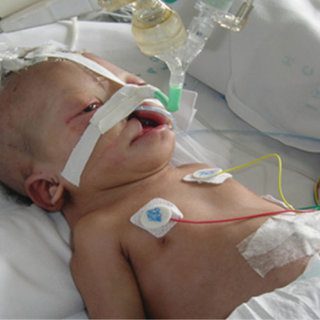Contents
Trisomy 22, a rare but serious trisomy
Whoever says “trisomy” means “trisomy 21” or Down syndrome. However, trisomy is a chromosomal abnormality or aneuploidy (abnormality in the number of chromosomes). It can therefore concern any of our 23 pairs of chromosomes. When it affects pair 21, we talk about trisomy 21, the most common. The latter is observed on average during 27 pregnancies out of 10.000, according to the High Authority of Health. When it concerns pair 18, it is a trisomy 18. And so on. Trisomy 22 is extremely rare. Most often, it is unsustainable. Explanations with Dr Valérie Malan, cytogeneticist in the Histology-Embryology-Cytogenetics department of the Necker Hospital for Sick Children (APHP).
What is trisomy 22?
Trisomy 22 is, like other trisomies, part of the family of genetic diseases.
A human body is estimated to have between 10.000 and 100.000 billion cells. These cells are the basic unit of living things. In each cell, a nucleus, containing our genetic heritage with 23 pairs of chromosomes. That is, in total, 46 chromosomes. We speak of trisomy when one of the pairs does not have two, but three chromosomes.
“In trisomy 22, we end up with a karyotype with 47 chromosomes, instead of 46, with 3 copies of chromosome 22”, underlines Dr Malan. “This chromosomal anomaly is extremely rare. Less than 50 cases have been published worldwide. “These chromosomal abnormalities are said to be” homogeneous “when they are present in all cells (at least those analyzed in the laboratory).
They are “mosaic” when they are only found in a part of the cells. In other words, cells with 47 chromosomes (including 3 chromosomes 22) coexist with cells with 46 chromosomes (including 2 chromosomes 22).
What are the causes and consequences of Down’s syndrome?
“The frequency increases with maternal age. This is the main known risk factor.
“In the vast majority of cases, this will result in a miscarriage,” explains Dr. Malan. “Chromosomal abnormalities are the cause of approximately 50% of spontaneous miscarriages occurring during the first trimester of pregnancy,” notes Public Health France on its site Santepubliquefrance.fr. In fact, most trisomies 22 end in miscarriage because the embryo is not viable.
“The only viable trisomies 22 are the mosaic ones. But this trisomy comes with very serious consequences. “Intellectual disability, birth defects, skin abnormalities, etc. “
Homogeneous or mosaic trisomy
“Most often, mosaic trisomies 22 are the most common apart from miscarriages. This means that the chromosomal abnormality is only present in part of the cells. The severity of the disease depends on the number of cells with Down’s syndrome and where these cells are located. “There are special cases of Down’s syndrome confined to the placenta. In these cases, the fetus is unharmed because the abnormality affects only the placenta. “
“The so-called homogeneous trisomy 22 is much rarer. This means that the chromosomal abnormality is present in all cells. In the exceptional cases where the pregnancy progresses, survival to birth is very short. “
What are the symptoms ?
Mosaic trisomy 22 can lead to many disabilities. There is a great variability of symptoms from person to person.
“It is characterized by pre and postnatal growth retardation, most often severe intellectual deficit, hemi-atrophy, skin pigmentation abnormalities, facial dysmorphia and cardiac abnormalities”, details Orphanet (on Orpha.net) , the portal for rare diseases and orphan drugs. “Hearing loss and limb malformations have been reported, as well as kidney and genital abnormalities. “
How is the diagnosis made?
“The children concerned are seen in genetic consultation. The diagnosis is most often made by performing a karyotype from a skin biopsy because the anomaly is not found in the blood. “Trisomy 22 is often accompanied by very characteristic pigmentation abnormalities. “
Taking charge
There is no cure for trisomy 22. But “multidisciplinary” management improves quality of life, and also increases life expectancy.
“Depending on the malformations detected, the treatment will be personalized. »Geneticist, cardiologist, neurologist, speech therapist, ENT specialist, ophthalmologist, dermatologist… and many other specialists will be able to intervene.
“As for schooling, it will be adapted. The idea is to set up support as soon as possible, to develop the capacities of these children as much as possible. As with an ordinary child, a child with Down’s syndrome will be more alert if they are more stimulated.










